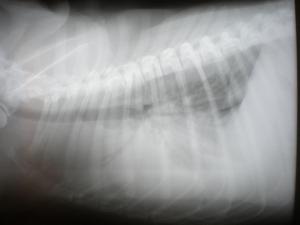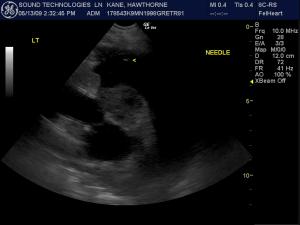Clinical Differential Diagnosis
Clinical Differential Diagnosis (Lobetti DECVIM)
Cardiac disease:
Dilated cardiomyopathy
Pericardial effusion:
Idiopathic
Neoplasia
Pleural space disease:
Neoplasia
Diaphragmatic hernia
Pyothorax
Chylothorax
Haemothorax
Hypoproteinaemia
Mediastinal obstruction/mass
Lung disease:
Parapneumonic effusion
Lung lobe torsion
Sonographic Differential Diagnosis
(Lindquist DABVP): Heart based mass consistent with hemangiosarcoma and severe pericardial tamponade.
Sampling
US-guided thoracocentesis and pericardiocentesis were performed (Lindquist DABVP, Nicolas RDMS, Epple DVM).
Outcome
(Lindquist DABVP, Nicolas RDMS): Immediately after the pericardial effusion was drained, the patient was started on Doxorubicin therapy and walked away asymptomatic from the drainage procedure. He responded well to therapy and finished out five treatments of Doxorubicin. After more than four months the patient was reported to be doing well and clinically stable. Current therapy included omega-3 fatty acid supplement and NSAIDS. The patient survived with a good quality of life for 6 months at which time tumor regrowth to 3 times the original size, pericardial hemorrhage and tamponade caused excessive weakness compromising quality of life. Follow-up echocardiogram findings confirmed this suspicion. The owners were very content with the extra 6 months of quality time even though empirical chemotherapeutic intervention was the mainstay of treatment.





Comments